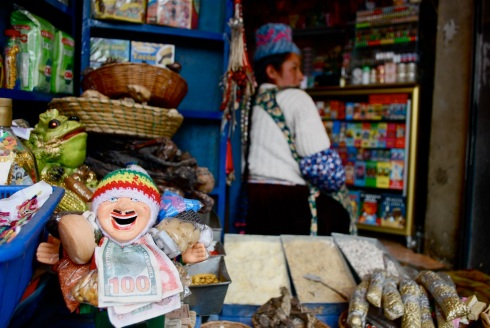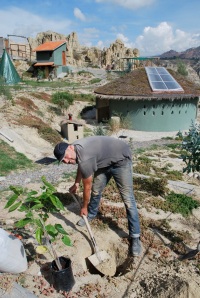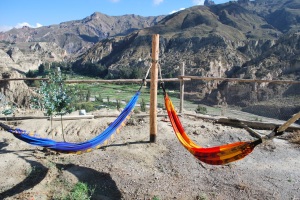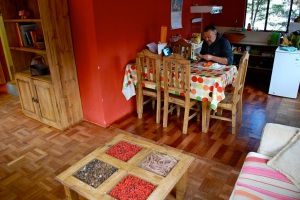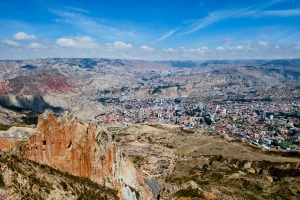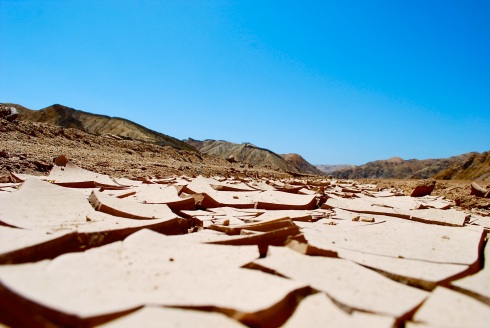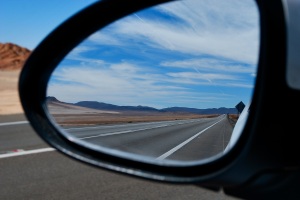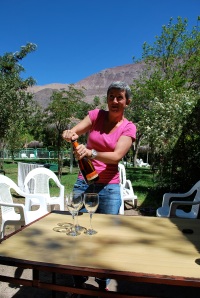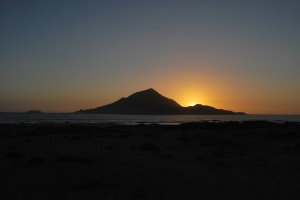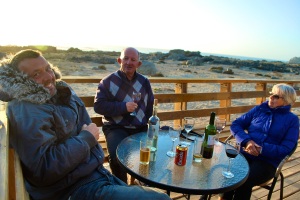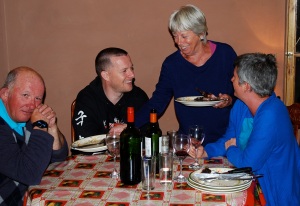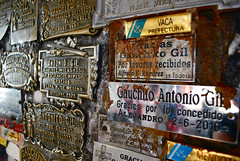Jupapina, near La Paz, Bolivia
[by Paula]
I’m not going to get all earth mothery on you, but our recent voluntary work in Bolivia is teaching us a hell of a lot about what it takes to manage a piece of land in a place where the weather can be brutal and the terrain unpredictable.
Every day, it seems, we are more or less engaged in a friendly tussle with nature. This is life for so many people in the world, but our post-stamp-sized garden in London wasn’t much of a training ground.
If we’re not trying to repair the ravages of the rains, we’re struggling to rehydrate the sun-parched earth, sweeping up wind-blown debris, helping to knit the slopes together with new trees or trying to keep termites at bay.
And what a place to do it. We’re perched above a dramatic, jagged-rocked, valley south of La Paz. Every day we are both living and working with the most incredible views into the Valley of Flowers, and down the Valley of the Moon towards the city, which twinkles in the distance at night.
What are we doing here, and why? Let’s recap – a few months ago we decided to hold off the southward journey until 2014, and to find a place to stop and do a work-exchange project, whereby we’d get some free accommodation in return for some hard graft. We specifically wanted hard graft – after a few sedentary months, Jeremy was particularly keen that his job description included ‘digging’. Deep down, he’s a simple fellow with simple needs.
He got what he wanted. We’ve been here a month, the blisters are hardening, the biceps are starting to form nicely, and we’re loving it.
Through the Workaway website, we found this fabulous place in a semi-rural Aymara village called Jupapina, where we’re now living for a few months. It’s the base for a range of community projects, collectively called Up Close Bolivia, which was established by British-Bolivian couple Emma and Rolando Mendoza. Up Close employs locals to run and staff the projects – for example a large children’s daycare centre – and provides international volunteers to help out.
On the land is the Mendoza family home, three volunteers’ houses, and – coming soon! – Emma and Rolando’s first commercial venture, a brilliant campsite that will open next year. This is where we come in.
Although we live among the Up Close ‘family’, we were recruited separately by Emma and Rolando to help with loads of odd jobs around the gardens, campsite and buildings. And there’s plenty of it.
This terraced land is porous and precipitous. After rains we are filling in water-created holes, which have reached up to 10ft deep, to make sure everything stays stable. When we are not filling in holes with piles of dirt, we are digging holes to plant trees, to help everything stay stable. We have painted acres of wood with anti-termite chemicals. We have cleared, tidied and swept. Rainy season should be upon us, but so far we have had weeks of glorious weather. The lack of rain means spending hours watering hundreds of trees. When it does rain we have to re-dig channels around them, to stop the water from pouring straight down into the valley and taking the earth with it.
We’re also here to help finish and market the campsite, and have so far set up an initial blogsite to start promoting it to interested parties.
Working on such steep land, at this altitude, is doing wonders for our fitness levels, and is also utterly exhausting.
After our morning’s work, we have lunch with Rolando and their housekeeper, and then spend the afternoons on chores or attempting to organise some freelance work. Sometimes we just fall asleep though…
We’re living in a converted pigsty, along with volunteer co-ordinator Naomi, but I suspect we have a way better deal than the porky residents had.
It’s been lovely to have a nice home, a routine, and some semblance of a social life again. We made great friends with Alison and Doug, a Canadian couple who came to volunteer with Up Close and were here for our first month, but have sadly now left. It was lovely to share some beers and laughs, and to get some baking tips from Alison, who’s a professional chef. I am no longer afraid to bake bread or scones!
Emma and Rolando, and their kids David and Bell, have been insanely welcoming, inviting us to their BBQs and other events, introducing us to their friends and colleagues, helping us with contacts and just generally being extremely tolerant of piles of volunteers wandering about the place and traipsing into their house to use the washing machine.
It’s a way of life for them and I’m not sure they remember it being any other way.
They’re both fascinating people, with backgrounds in development and public service. We spend most of our days with Rolando – former mayor of the local town and director of social services for La Paz city – and chatting to him about all sorts of political and social issues is great practice for our Spanish!
Talking of Spanish, within a few days of our arrival Rolando suggested we’d make good interviewees on one of the big La Paz radio stations, Radio Compañera. We laughed it off, saying our Spanish would not hold up to a live radio interview. A week later Emma came to us one evening saying: ‘You’ve been invited onto Gringo González’s show tomorrow morning.’ As is quite common, he’s nicknamed ‘gringo’ because his hair is slightly lighter than black. It was be a half hour interview about us, media issues in the UK and Latin America and whatever else cropped up. We gulped, hyper-ventilated, tried to avoid saying yes… then said yes. Shit!
Next morning, we couldn’t believe we were sitting there. The clock counted down til 11am and we were on air. Unbelievably, we survived it without any hideous dead air, hilarious misunderstandings or (we think) major bloopers. Our mistakes were diplomatically ignored! We lost several pounds in sweat. The subject matter bounced all over the place from threats to journalists in Colombia, to our own travels, to BBC funding, to what we thought of Margaret Thatcher. Luckily we knew the word for “witch” in Spanish. Phew.
Our weekends are our own and we’ve been getting out and about – with some city jaunts, to Bolivia’s main archaeological site of Tiwanaku, hiking to the ‘Devil’s Molar’ (a craggy rock formation that we can see, across the valley, from our window), to a big La Paz football derby – el clásico between Bolívar (yay!) and The Strongest (boo!) – and a weekend in a lush valley at Coroico.
Some 2,000m lower than La Paz, it was like another world, with its tropical flowers, dense forests, amazing birdlife and clouds of mosquitoes. Ah, mosquitoes, how we haven’t missed you.
We are preparing for a trip to Lake Titicaca this weekend, which will – not entirely accidentally – coincide with Jeremy’s birthday.
I’ve promised he can have a whole weekend of decadence – hotel room, lovely food, a few cold beers, and not a spade in sight.
Days: 792
Van miles: 17,551 (to Ecuador – where the van remains for now)
Non-van miles!: 7,449
Things we now know to be true: Slagging off Margaret Thatcher in Spanish feels just as good.
PICS PICS PICS! Photo gallery below from the last few weeks.
—-

